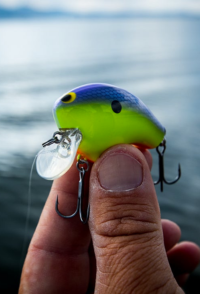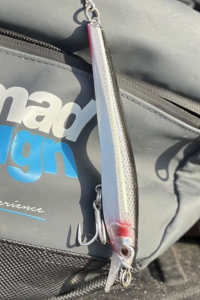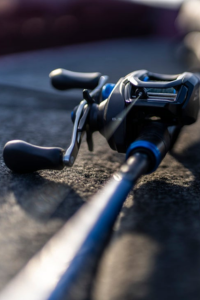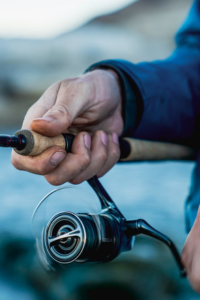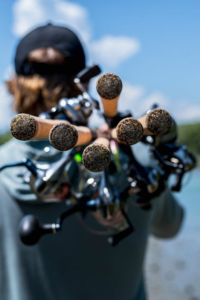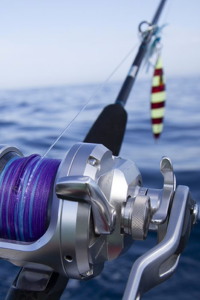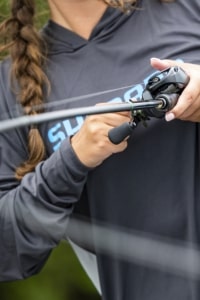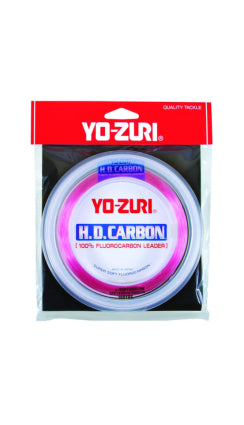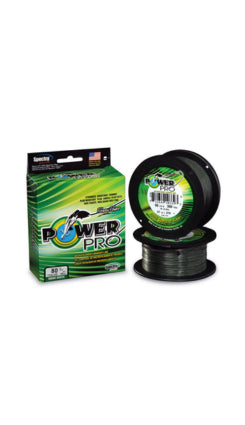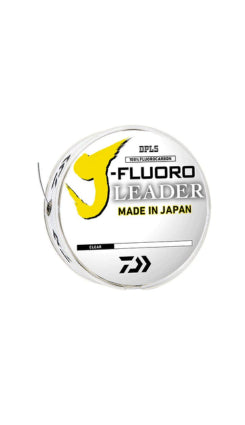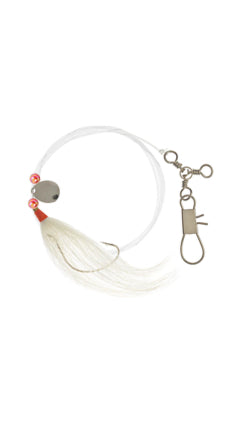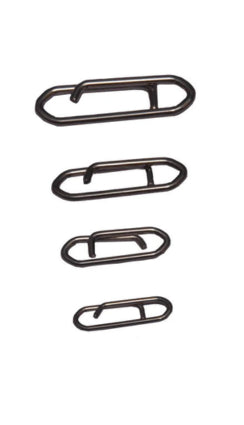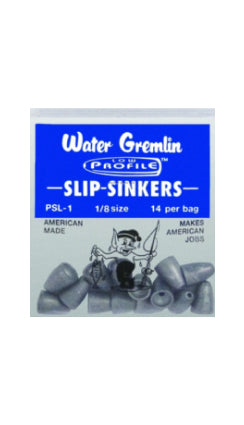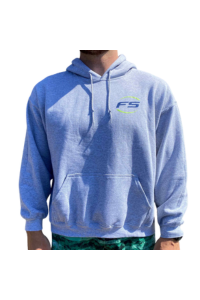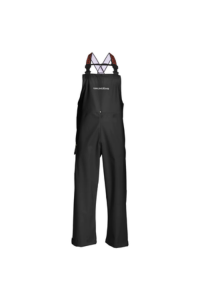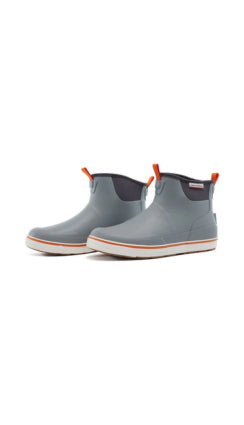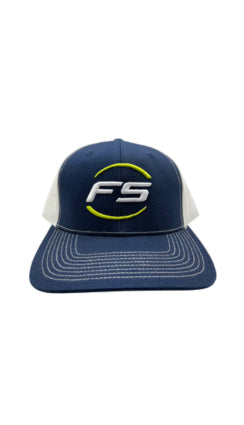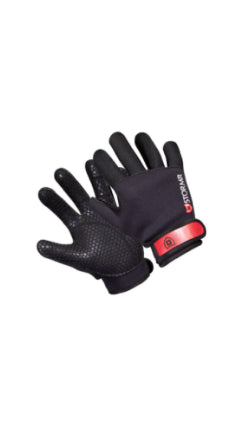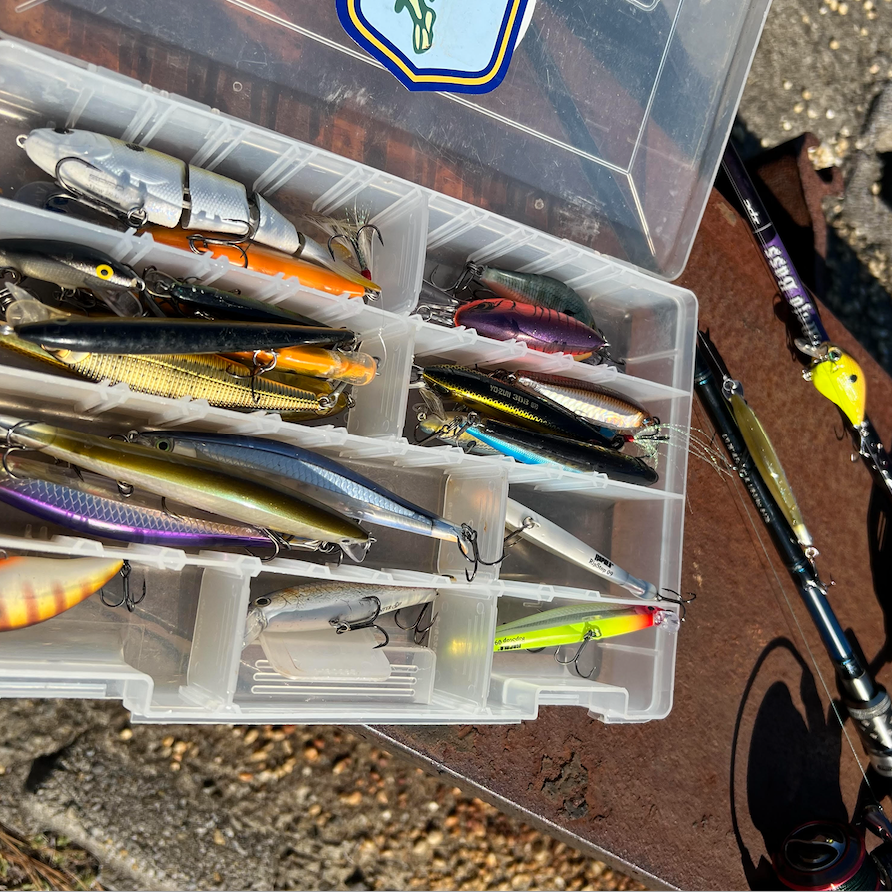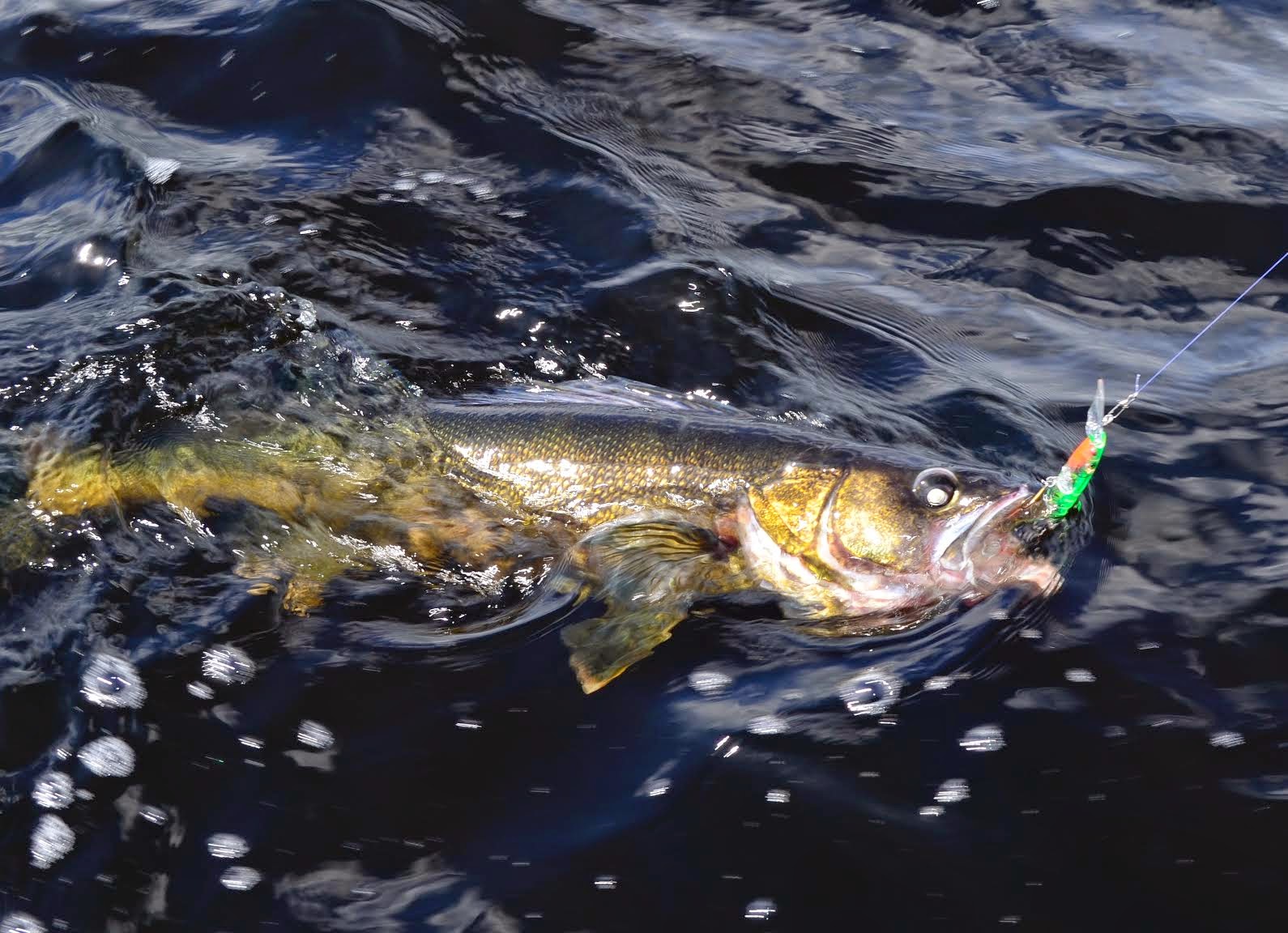It was one of my first days off in a while, and I hadn’t been out scouting the beach in weeks, and yet as I walked up the surf’s edge in the gray light of that early October morning 10 or so years ago I could hear fish feeding and bait boiling. I tied on a rubber tsunami shad and hooked a beautiful schoolie bass on my very first cast. Cast after cast I connected with either a mid-20” sized bass or a cocktail blue with a slightly larger specimen thrown in occasionally. As gray light slowly turned to day the blitz intensified a bit but bluefish started to come on stronger. Unfortunately for me, with daylight came other anglers that could see the birds working and fish chewing. Even as it became more and more crowded, most anglers worked together and seemed to have some idea what they were doing. Fish were being pulled in all around and everyone was laughing and smiling.
It was about this time that yet another bluefish bit off the tail of the last swim shad in my bag. I paused for a minute to look and see what else was in my bag that might happen to resemble a small bunker. Suddenly something caught my eye out beyond the main body of blitzing fish. It wasn’t the same splash we had been seeing all morning, it was a swirl, and a big one at that. I dug a large wooden swimmer with a green back and a white belly out of my plug bag and started launching way beyond the blitz while retrieving very slowly, just enough to make the bait V-wake. For the next 45 minutes I threw that bait cast after cast without so much as a bump while fish were still being landed all around.
I had multiple anglers offer me smaller plugs or rubber shads, but I had caught more than my share of small fish that morning. Now I was determined. The sun was well up into the sky and the main body of both predators and bait had just about broken up when it happened. About 50’ from the beach my plug just disappeared in that tell tail swirl and I was on. It was a classic big striper fight. A good long first run, a few big headshakes, a few minor runs and I slipped her up on the beach. I quickly removed the hook and popped her on my 30lb Boga which she nicely bottomed out and after a few minutes revival in the wash, she was off on her way.
It Is All About the Bait: The fall bite and the technique you will be using day to day and even minute to minute will change based mainly on what bait is present in the wash at that time. One of the things that can cause such good fishing off the beach is the abundance of bait that travels through the surf zone. At various times I have seen finger and cob mullet, peanut and adult bunker, sand eels, spearing, rainfish, baby weakfish, hickory shad, herring, snapper bluefish, various crabs, and more on the same beach at various times throughout the fall run. Knowing what type of bait is in front of you will give you a huge advantage when it comes to knowing what type and color of lure or plug you should be using.
Rods and Reels: Ask ten different surfcasters their favorite plugging set up and you will get 10 different answers. So, I am not saying what I recommend is the best, or even that it is what you should be using, but it certainly works for me. My primary plugging stick and the one that I use easily 80% of the time in the fall, and almost exclusively at night is an Airwave Elite 9’6” rated ¾oz to 3oz I pair it with a Shimano Saragossa 6000SW spooled with 30lb Power Pro Slick 8. With this light set up I can cast for hours without fatigue, handles striper and bluefish of all sizes with no problem, and most importantly throws the ¾ to 1 1/2oz lure I primarily use in the fall very well.
The second combo that generally stays in my car for the fall is the same one I use in the spring for pencil popping; a Tsunami Airwave Elite 11’ Medium paired with a Tsunami Shield 6000 spooled with 40lb Power Pro Maxcuatro. This set up only comes out when larger bait is present, and I need to throw larger and heavier plugs or poppers, or if the surf is running particularly rough and I am using larger metal baits with a teaser ahead. One morning this set up proved its worth as bass were working a pod of sand eels on the bottom on the very outer edge of a bar almost 100 yards offshore. There was a heavy North to South sweep going on and lighter offerings just weren’t getting deep enough to be noticed. Using a 4oz diamond jig with a small teaser I managed over a dozen 28” to 36” bass on an otherwise fishless morning.
Lures and Terminal Tackle: My terminal tackle in the fall is generally simple. I fish a 15’ or so mono shock leader on the end of my braid of 30lb or 40lb Ande pink mono. I then tie a small 130lb Spro barrel swivel with three to four feet of 40lb Seaguar Blue Label Fluorocarbon ending with Tactical Angler clip of either 75lb or 125lbs. At night or during the day when I suspect that small bait might be present in the area I will tie a dropper loop in my leader about 28” ahead of my primary offering and slip a small bucktail teaser onto it. Depending on the fall anywhere from 25% up to 60% of the fish I catch will be on the teaser rather than the primary lure. There are several types, sizes, and color teasers out there, but for starters it is hard to beat an olive over white bucktail with a bit of Mylar tied in for flash. I often see anglers out fishing who have their teasers rigged only 12” to 18” ahead of their plug, and while this rig is certainly easier to cast then a long rig, I have personally found that the more distance between the teaser and the plug the more productive you will be.
If I am walking up to the beach in the pitch darkness as is often the case in the fall and I am not sure what is going on, 95% of the time I am going to tie on a Daiwa SP minnow 15F in either a blurple or chicken scratch color with a teaser a few feet ahead of it. This set up isn’t necessarily the best at imitating anything, but it is MY confidence bait and that is a very powerful tool all on its own. Fall fish are very opportunistic and looking to feed for the long winter and migration ahead. If you can put a well presented offering in front of them, particularly at night you have a very good chance at getting bit. Another bait I would not be caught without in the fall is a white bucktail jig with either a curly tail or otter tail trailer. This bait is great at any time but especially in the late fall. When the schoolies stack up, they will often crush a slowly retrieved and barely jigging bucktail. Plus, if you are dealing with all small fish, having only one single hook to deal with is safer for both you and the fish.
When you can identify what bait is present, it is time to get selective. I find peanut bunker best imitated with either a paddle tail shad such as a Tsunami Pro Swim Shad Holographic Swim Bait or a small metal lipped swimmer. A chicken scratch colored bomber 16A tends to be a great bait early in the fall when finger mullet makes an appearance. If you are lucky enough to find sand eels stacked up on a beach or outer bar, thin profile metal baits like diamond jigs as well as small rubber eels like the Tsunami Sand Eels are real killers. One of the harder time to catch fish in the fall is if the primary bait is spearing or rainfish, small bait with a very small profile. In this situation an experience fly caster has a distinct advantage but if you are like most of surf casters that prefer spinning or casting tackle, a small bucktail teaser tied several feet ahead of your plug or metal will often provide fast action. When larger bait such as adult bunker or herring present themselves in the surf, my personal favorites are larger metal lip swimmers in the 6” + size range. Many great builders out there produce some truly beautiful hand-crafted plugs that mimic larger baitfish and produce very well, but for the average angler on a budget, the Tsunami TS Forty Metal Lip Swimmer has great action at a reasonable price.
Whatever lure or lure combination you choose, be sure to vary your retrieve as you fish until you find out what speed the fish want to respond to. This is particularly true of swimming plugs at night. When I first started surf fishing many years ago, I was given this advice. Slow down until you think you are working your plug too slowly, and then slow down again by half. I find that the slower I can crawl a plug while keeping contact with it, the more successful I am.
Time and Tide: If I have been surf fishing I get the same two questions repeatedly. The first is; What is the best tide to go fishing? While certainly certain specific spots do fish better on a rising or falling tide, I honestly don’t really have a preference in the fall except that I want moving water. Meaning, I generally have not done as well directly on high or low tide. If you are fishing a location with a sandbar offshore of the beach as in the case in much of central New Jersey, many people feel that better fishing occurs on the upper half of the high tide. Some feel that fish are more likely to come over the bar and into the trough when the tide is up. This certainly can be true, but I have also caught plenty of decent fish in the trough at low tide. The second question that is constantly asked is what is: what is the best time of day to go fishing? Ten years ago, I would have answered without hesitation that in the fall nighttime (meaning full darkness) is the best time for catching stripers. The past few years, however, I have found more willing fish are caught in the daylight. I am sure that the larger peanut bunker runs are partly the reason for this as I find the bunker are more apt to push further offshore under the cover of darkness. While I still prefer nighttime striper fishing since it has fewer anglers and more peaceful atmosphere, I would say anytime you can get to a beach on moving water is the right time to fish. One factor that many new anglers often overlook is wind direction. I personally pay more attention to wind direction then most other factors when surf fishing. New Jersey ocean front beaches tend to be most productive on a West or Northwest wind, or the first day of a North-East blow.
Final Thoughts: Every year is different. Some falls are great while others are more of a grind. Some years the best action is in October but during others we have great fishing around Christmas. So far this fall we have had way too much South and Southeast wind for my liking, and it has certainly put a damper on my fall run. I have absolutely no doubt, however, that those of us that put in our time will eventually be rewarded with some great cold nights of spunky stripers on the beach. The last few years my best catches have come in areas where there have been no reports of quantity of fish being caught and during times when many of the internet “sharpies” have been complaining of no fish. Just remember you can’t catch anything from your bed, and the winter is long and cold. Fish when you can, and eventually you will find a big school of fall stripers to call your own.

